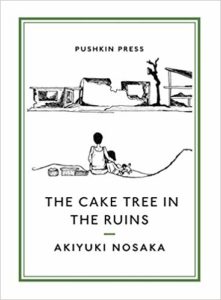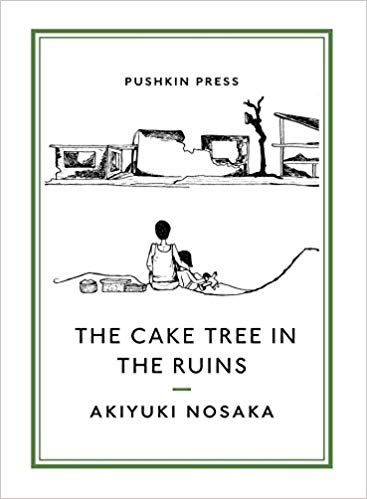
“The Cake Tree in the Ruins by Akiyuki Nosaka is a translation of Senso dowashu, a collection of war tales that are absolutely brilliant and heartbreaking” —Ginny Tapley Takemori
(See our review of Cake Tree in the Ruins)
In 1945, Akiyuki Nosaka watched the Allied firebombing of Kobe kill his adoptive parents, and then witnessed his sister starving to death. The shocking and blisteringly memorable stories of The Cake Tree in the Ruins are based on his own experiences as a child in Japan during the Second World War.
There are stories of a lonely whale searching the oceans for a mate, who sacrifices himself for love; of a mother desperately trying to save her son with her tears; of a huge, magnificent tree which grows amid the ruins of a burnt-out town, its branches made from the sweetest cake imaginable.
Profound, heartbreaking and aglow with a piercing beauty, they express the chaos and terror of conflict, yet also how love can illuminate even the darkest moment.
Excerpt:
Of course there was no electricity, so once the sun went down all they could do was sleep.
Depending on your perspective this could be considered a very healthy lifestyle, but then there was no escaping the lack of food. Daily rations had been reduced from 350g to 320g and consisted not of rice but of defatted soy flour or maize, and even then usually arrived late. It was possible to purchase food in the countryside, but everything had been destroyed in the fires so nobody had anything to offer in exchange. Even if you did have any money it was hardly worth the paper it was printed on, while workmen’s outfits were in high demand—rubber-soled split-toed boots, work gloves, gaiters, that sort of thing.
Adults were better at enduring these conditions, but it was really tough on growing children, especially since it was the grown-ups who had gone to war in the first place while the children were simply innocent victims. For those children between the ages of five and ten in 1945, it really was a miserable existence—they had never eaten anything tasty, while however hungry the grown-ups were now they could remember eating their fill of delicious food in the past.
They would reminisce about the tasty eel in such-and-such a restaurant, and the mouth-watering tempura in another, especially the shrimp and vegetable fritters. Having really indulged themselves in the past, now that life was a bit tough they could reconcile themselves to going without.
However, the children didn’t even have memories to sustain themselves with. Rice had been rationed since 1941, sugar was hard to come by, the cakes and candies that had once flooded into the ports had vanished, and by the end of the war the only sweets available were dried bananas and sweet potatoes.
In order to survive, the children formed gangs to go scavenging for the tomatoes, cucumbers, pumpkins and other vegetables people had started growing in the ruins. They knew it was wrong to steal, but survival was more important to them, and they could sniff out exactly where tomatoes were turning red or pumpkins were swelling up nicely.
“Hey, what’s this tree?”
One day, they came across a single tree growing vigorously amidst the ruins. While the weeds were flourishing, all
the trees had been burnt down and any that had somehow escaped the worst of the flames had been cut down for
firewood, so it was quite impossible for there to be any healthy trees left standing. Yet this tree was full of vitality, stretching its leafy branches up to the blue sky. Indeed, it seemed to be growing before their very eyes.
“Why here?”
“This is where that big house once was. I used to come here to collect cicadas.”
“But everything must have burnt down.”
“There were a lot of trees in the garden. It must be one of those.”
“But the leaves aren’t even a little bit dried up.”
Some trees surrounding a shrine a short distance from the ruins had survived, but all their leaves had been scorched by the heat from the flames. Yet the leaves on this mysterious tree in the ruins of the big old house seemed to be sprouting one after another with fresh green growth.
“Mmm. It smells nice.”
“Yeah, and those leaves look quite tasty.”
“Don’t be silly, since when did anyone ever eat tree leaves?”
The children all knew as well as any botanist what plants they could or couldn’t eat, but they had never heard
of tree leaves being edible, however tasty they might look. Well, apart from persimmon leaves, which were dried to
make a flour that tasted slightly sweet.
One of the boys reached out and grabbed a leaf from the mysterious tree and crammed it into his mouth. He munched on it for a moment and then exclaimed loudly, “Waaah! Yum!” The boy who had been so sure that tree leaves were inedible also picked off a leaf and put it his mouth, then all of a sudden all the children were scrambling up the tree and hanging off branches to get at the leaves. A branch snapped off, releasing a sweet fragrance. The children were stunned.
“Hey, look at that!” said one, pointing at the place where the branch had broken. The age rings were clearly visible,
as they should be, but strangely the sweet smell seemed to be emanating from just that point.
“It’s soft!”
“Soft?”
“Yes, soft.”
He touched the tree and then put his finger in his mouth, and was instantly transfixed. Seeing this, the others all wordlessly followed suit, timorously touching the scar on the tree trunk and then licking their fingers. It was soft and sweet.
When they finally came to their senses, they realized this soft sweetness on their tongues was unlike anything they had ever tasted before. Everything they had eaten until now had felt coarse in their mouths, and had tasted salty. Boiled wheat-bran dumplings felt like sand, defatted soy was just like gravel, and there really were often little bits of grit mixed in with the rice gruel.
All the children started breaking off branches and gobbling them up. The tree looked just like any other ordinary
tree with hard branches, but the moment they put a piece into their mouths, it melted on their tongues and an indescribably
sweet taste spread through their entire bodies…..
End of excerpt. See our review of Cake Tree in the Ruins.
About the Author: Akiyuki Nosaka (野坂 昭如) (1930 – 2015) won the Naoki Prize in 1967 for his stories Grave of the Fireflies and American Hijiki.

